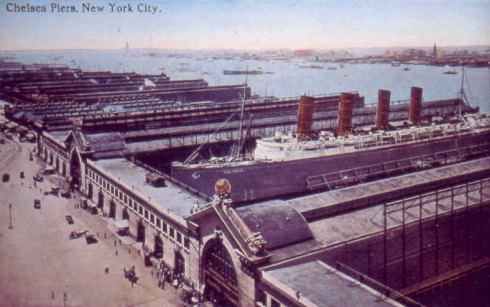Pier 54 in its heyday, with the RMS Lusitania in port.
All that remains of Pier 54, the iron arch, where New Yorkers once waited to greet the RMS Titanic.
There have been a number of days of great sadness for the people of New York City. But giving a tour yesterday on the 100th Anniversary of the sinking of the Titanic moved me in unexpected ways.
Standing in front of the White Star Offices with my new friends from Washington and California and Kentucky, I could almost taste the desperation of the families storming the building as word trickled in and painfully slowly of those we lost that terrifying night, in the cold, off an iceberg miles from the coast of Newfoundland.
Isidor Strauss, the owner of Macy's Department Store, was found floating lifeless in the frigid waters. His wife, Ida, who had made it on to a lifeboat only to get back on the Titanic when she saw they weren't allowing her husband to go with her, was never seen again. John Jacob Astor IV, the wealthiest man on board, the scion of the oldest monied family in NYC, was also found dead in the water, his face blackened by the coal of one of the famous funnels that had snapped from its tethers and crashed onto those desperately trying to stay afloat. But the great majority of the victims were those third class passengers, the immigrants like our own ancestors, whose hearts were filled with hope of life in a new land where hard work might one day pay off, where their children might one day own a home and have an education. Simple dreams, dashed at sea.
I thought of the people that lined the Hudson River up to the White Star Pier at 14th Street, only to see the SS Carpathia arrive with the small fraction of survivors and a larger hold filled with bodies that did not survive, to be laid out on the floor of the ballroom of the Jane Street Hotel for identification. I thought of the days and weeks of confusion as misinformation gave many false hope, that perhaps the Titanic survived and was being towed to Virginia, a story that gained much traction in the minds of those family members who would do anything to keep their hope afloat.
I thought of the sad fact that there are no more survivors of that terrible, terrifying night alive anymore, those people who lived out their lives with the knowledge that they were somehow lucky beyond lucky, that fate had passed over them for the time being, that their stories would be mangled by newspaper men and The White Star Lines' official version of the events, tainted by a company hoping to avoid prosecution. But this was the end of the fabled White Star story. And the stories of the victims would eventually be heard.
It was also the end of a world as we knew it. The inequities of the class system that caused the disproportionate death of the poor that night would not go unnoticed. It was, perhaps, not a coincidence that this event led to the downfall of the greatest dynasties Europe had ever known, and that we would soon plunge headlong into a War of the World. Systems broke down everywhere, and in many cases, for the better. Most certainly not always, but often. The sinking of the Titanic heralded in a Century of Death and rivers of blood would spill in the hopes of creating a fairer world. Much of that carnage was by design. But it all began with a rather coincidental run-in with a piece of ice that had broken off an ice field eighty miles away on a crystal clear night at the height of man's sense of invulnerability.
We are vulnerable now. We always have been. But it took this titanic event to remind us. And remind us again 100 years later.


No comments:
Post a Comment